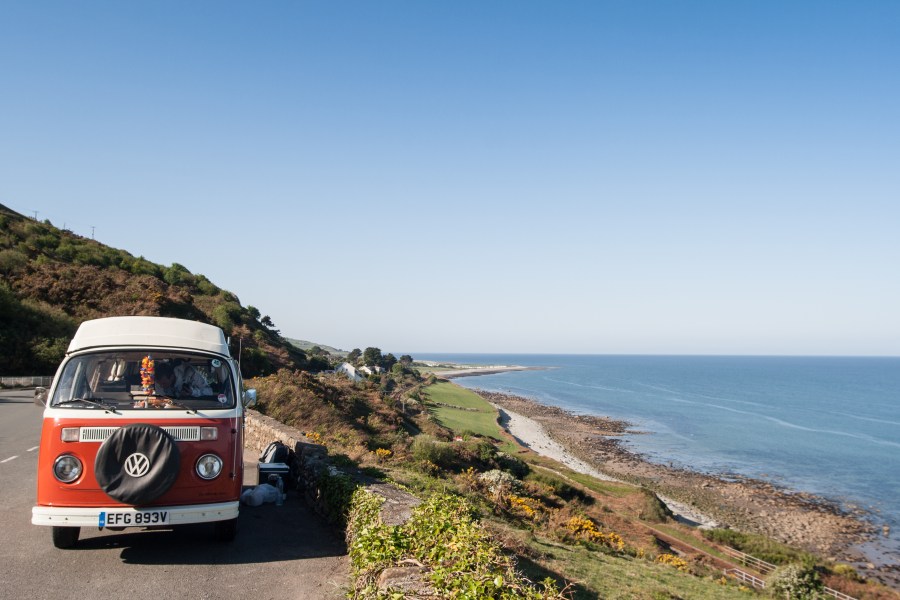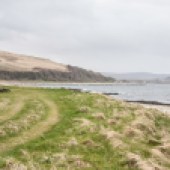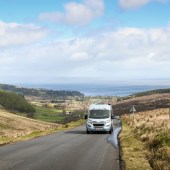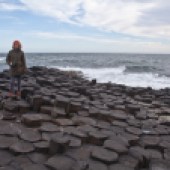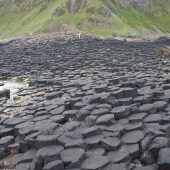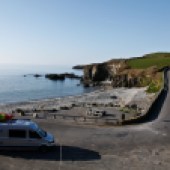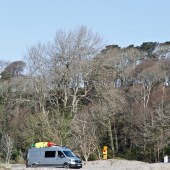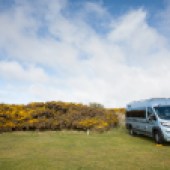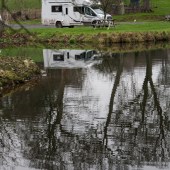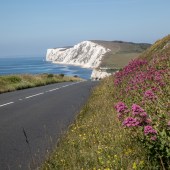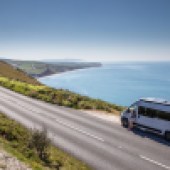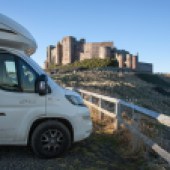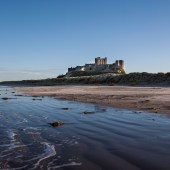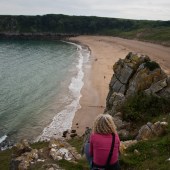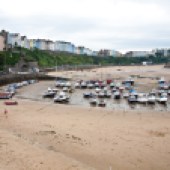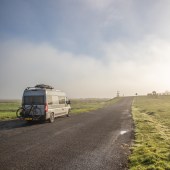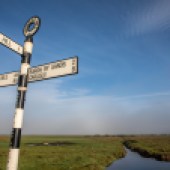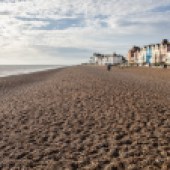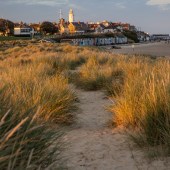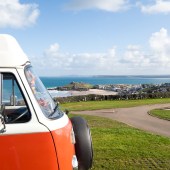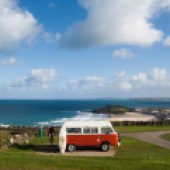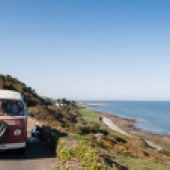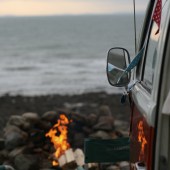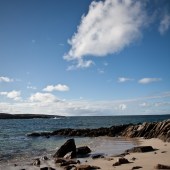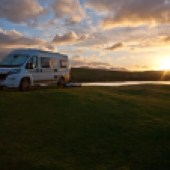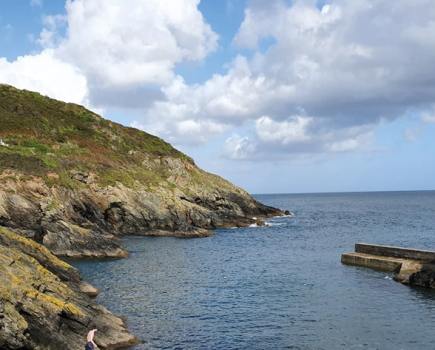Writer MARTIN DOREY has spent a lot of time in the last few years travelling around the UK and Ireland by campervan for his Take the Slow Road series of books. Coast asked him to come up with a few ideas for amazing coastal places to visit in a campervan this autumn. And here they are: 12 of the best in the UK and Ireland.
1. THE PEMBROKESHIRE COAST
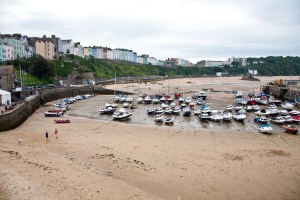
Pembrokeshire has long been a favourite place to take a camper. But the rules have changed slightly since Covid-19 brought the whole world to this little corner of Welsh heaven. The Pembrokeshire Coast National Park Authority welcomes campervans but only if you stay at a campsite – and that’s no headache as they abound. If your idea of campervan nirvana is a coastal site with sea views, access to the Wales Coast Path and an easy walk to pubs and picturesque coastal villages, Pembrokeshire will oblige.
The island oasis of St David’s, Britain’s smallest city, has everything you might need for a coastal campervan caper, including restaurants, pubs, an incredible Cathedral and, some say, the best ice cream this side of Italy. The city is served by a cheap, regular bus service, The Celtic Coaster, which will enable you to walk the coast path without worrying about transport. Leave the van and head out for the day. Heck, you can even leave the bed made up – ready to flop into at the end of the day!!!
Tenby, perennial favourite, is bright and breezy while the beach at Barrafundle is said to be among the most beautiful in the world and the Blue Lagoon at Abereiddy is one of the best places to wild swim anywhere. Keen young wizards might want to find Dobby’s final resting place at the stunning Freshwater West Beach – just don’t leave him your socks.
PITCH UP AND CHILL AT
Caerfai Farm Campsite, a good, old fashioned campsite with its own beach! caerfaifarm.co.uk
Newgale Campsite, surfer’s favourite and right next to a fabulous beach. newgalecampsite.co.uk
DON’T MISS OUT ON
Exploring the coast. St David’s is the home of eco-pioneers TYF Adventure. They can take you and your family coasteering (they literally invented it!), SUPing surfing, wild swimming and on days out to explore the coast by kayak. tyf.com
2. WILD WEST WALES
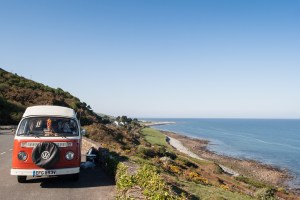
For me, travelling up the west coast of Wales in a campervan is where it all started. The journey, one of my all-time favourites, gave me the idea for writing my books, Take the Slow Road, after writing about it in this magazine. It’s a dreamy, slowcoach of a trip with stops at Tywyn, Barmouth, Harlech and Portmeirion. Start with some crabbing in Aberdyfi or climb up to Llyn Barfog, a small lake that’s covered in gorgeous yellow water lilies in the summer. Heading north, the road skirts the coast, at times clinging on to the steep hillsides by its fingertips, offering incredible views.
At Fairbourne, leave the van and pick up the narrow gauge railway to the tiny ferry to Barmouth for fish and chips then walk back on the famous Barmouth Bridge. There’s another rickety old bridge a little further upstream at Penmaenpool that’s worth the toll. Then it’s on to Harlech and Portmeirion, the Italianate village that belongs to another place and time.
For those who like walking the Cambrian Coast Railway covers the whole coast and is one of the most scenic anywhere. Leave the van, hop on and hop off and walk the bits between.
PITCH UP AND CHILL AT
Cae Du Campsite at Tywyn is one of the best campsites anywhere. Great sunsets and you can light fires. A Welsh classic.
Nyth Robin, a peaceful glamping and touring site near Aberdovey. nythrobin.co.uk/
Shell Island Campsite One of Europe’s biggest campsites with 300 acres of camping. About as wild as it gets, if you can find a spot in the dunes to yourselves. shellisland.co.uk
DON’T MISS OUT ON
A trip on the Fairbourne Narrow Gauge Steam Railway. It links up with a summer service on the Barmouth Ferry to grab the fish and chips in town. The Ffestiniog Railway is a heritage railway that will whisk you from Porthmadog to deep into the mountains and up to the slate town of Blaenau Ffestiniog.
Portmeirion, the Italianate village that still trades on its fame in a 1960s TV show, The Prisoner, is still absolutely lovely! Cwm Bachan is an amazing lake in the hills that’s difficult to get to (impossible in a big van) but worth the walk or cycle. Harlech Castle sits on a rocky crag and commands views over the dunes and river below.
3. SOUTHWOLD AND THE SUFFOLK COAST
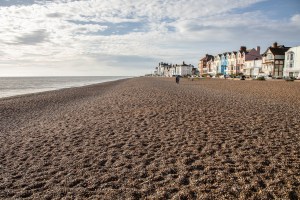
You don’t need millions to stay in Southwold, even if the colourful beach huts on Southwold’s beach front go for a king’s ransom. All you need is a booking at the nearby campsite. It’s council-run so it’s not expensive, and the location is sublime.
What the cost of a pitch buys you is easy access to the town and beach as well as a short stroll from the fish and chip shops of Blackshore, the popular working harbour. Catch a ferry across the river to Walberswick for a pint or a cream tea and for a dip. If you like quirky then don’t forget to trot along to Southwold Pier. The Under the Pier Show is an amusement arcade with a difference – just go! Afterwards, reward yourself with a visit to the Adnam’s Brewery. Medicinal purposes only.
Nearby there is plenty for the campervanner to pootle along to too: the RSPB’S Minsmere Reserve, home to Springwatch for a few years, is just a short drive away, as is Orford Ness, the Cold War secret that’s now a National Trust reserve. Both are absolute heaven for twitchers and great for peaceful, nature-filled walks. Great Yarmouth, to the north has one of the UK’s oldest roller coasters, The Scenic, one of only two wooden scenic railways still operational in the UK.
PITCH UP AND CHILL AT
The Eel’s Foot Inn at Eastbridge near Minsmere has hook-up and camping facilities. Great pub too. theeelsfootinn.co.uk
Southwold Caravan Site is in a great position near to the beach and is walkeable to the town. Handy for Blackshore Quay. southwoldcamping.com
DON’T MISS OUT ON
Sutton Hoo, the site of Anglo-Saxon burial mounds where the ghost ship and Britain’s greatest treasures were uncovered.
You can walk to Snape Maltings from Aldeburgh across the marshes. It’s a converted Victorian maltings that includes a concert hall, galleries, shops and cafes. Artsy and wonderful, with retail therapy, if you need that kind of thing.
4. ST IVES AND WEST CORNWALL
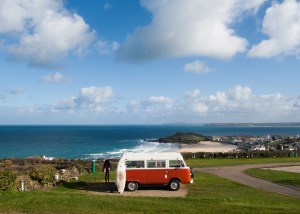
Where else can you camp on the edge of a beautiful town, with sparkling seas, white sands, amazing restaurants and world class art? Only in West Cornwall. I love St Ives, it’s official. Even though it’s close to home for me and has long been taken over by the tourist trade, it still feels exotic. And there is still a tiny part of my soul working a summer job at Windansea Surf Shop in Fore Street.
St Ives has a lot going for it for the campervan adventurer. For a start you can pitch up above the town at Ayr Holiday Park. They stay open all year and pipe Pirate FM radio into the loos for good measure. You can walk into the town in about ten minutes for food, art and beaches so there’s no need to pack up your pitch each day.
If that’s not entertainment enough, you can take the fabulous B3306 to Zennor, Cape Cornwall and on to Sennen Cove. It popular with cyclists so bring your wheels. You could walk the coast path through granite and heather to hidden coves with dazzling light. Or you could just put the kettle on and take in the views.
PITCH UP AND CHILL AT
Ayr Holiday Park has amazing views over St Ives and stays open all year. ayrholidaypark.co.uk
DON’T MISS OUT ON
The Tate Gallery has a wonderful permanent collection of art from the likes of Barbara Hepworth, Alfred Wallis and Ben Nicholson and the St Ives artists. For great swims try Jubilee Pool in Penzance, one of the best seaside lidos in England. It has a geothermal pool too!
5. THE ISLE OF WIGHT
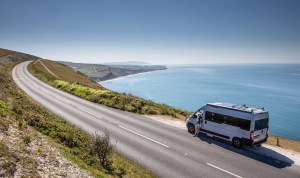
Taking a campervan to the Isle of Wight is like a mini-foreign adventure in itself. Roll onto the ferry at Portsmouth and roll off on a magical isle of red squirrels, deserted chines, kaleidoscope cliffs and botanical gardens.
I absolutely loved my trip to the island, simply because it felt a world away from anywhere. The driving is great but the distances are low so you can take it really slowly. Starting at Alum Bay in the west – site of the Needles and amazing multicoloured cliffs – a short drive will take you along the Old Military Road through Freshwater Bay to Compton Chine and on to Niton and Ventnor via St Catherine’s Point.
As always the coastal walking is incredible and the steep-sided ‘chines’ offer tantalising drops down to quiet beaches. The view from the top of the cliff at Compton Farm car park is incredible. But take the steep steps down to the beach and you’ll discover another world – a landslip between beach and clifftop – of meadows and pools, where flowers thrive and butterflies and dragonflies flit between them. On its day the beach here offers great bodysurfing or belly boarding and the chances are you could have a stretch of it to yourself.
PITCH UP AND CHILL AT
Stoats Farm, a lovely peaceful site with a great pub (The Highdown Inn) opposite. Pitches with electricity available. stoatsfarm.com
DON’T MISS OUT ON
The hottest hothouse (and garden) in the UK is to be found in the unique micro-climate of Ventnor’s Undercliff at the Ventnor Botanic Gardens, along with champion trees, magnolias and lots of tropical invaders.
For those who like a bit of seaside sauce, The Donald McGill (saucy seaside postcard) Museum at Ryde, offers a different kind of heat. Finally, Totland is a great place to keep cool on a hot day. There is fabulous swimming here.
6. THE NORTHUMBERLAND COAST
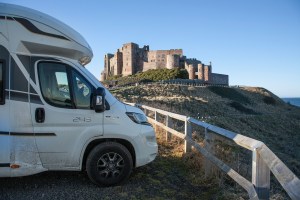
If you want a proper road trip, the Northumberland coast is it. It’s got a bit of everything, from a mystical tidal island at Lindisfarne to deserted sands, wild dune systems, more castles than you could shake a stick at, some buzzing seaside towns and a fine line in kippers smoked each day at Craster.
I went to Northumberland looking for solitude and, while parts of it were busy, like Seahouses and Bamburgh Castle, it wasn’t too hard to find vast expanses of sand with few people on them. And if I wanted seaside charm I only had to wander around Amble’s Harbour Village or stroll through Alnmouth. Berwick was a revelation too, full of art and artists, a great art centre and brilliant views of the coast.
I started in Whitely Bay and made my way north, following the coast as closely as I could to Berwick. Along the way I drove across the causeway to Lindisfarne (Tip: go at the end of the day as the tide recedes – it’s less busy as everyone who has been stuck on the island all day is desperate to leave), swam without my kit at the lonely Football Hole Beach, surfed at Cocklawburn Beach and planned a fantasy move to Spittal, a cosy beachside suburb of Berwick Upon Tweed.
Every place I stopped was magical, beautiful, enchanting. The best part of it was that it felt real, down to earth and perhaps a little surprised that anyone might want to come here. The sea might be chilly but who cares? It’s England’s best kept secret.
PITCH UP AND CHILL AT
Beadnell Bay Camping and Caravan Club Site, a huge site on the dune slacks behind Beadnell Bay. Right on the coast but big enough for hundreds of campers. tinyurl.com/bdehzkmy
Berwick Motorhome and Caravan Club Site, a brilliantly situated site overlooking the sea at Berwick. Nice wardens and good facilities as usual. One of the best C&MC sites I’ve been to. tinyurl.com/275nsvns
DON’T MISS OUT ON
Craster Kippers. Stock up on your way back from checking out the ruins of Dunstanburgh Castle. Can be a bit tricky with parking so get there early. Try Amble too. It’s a great fishing town with a nice seafront, lots of crafty seaside shacks and a quirky harbour village. Northumberland does castles and Warkworth is one of the best. Then again, Bamburgh Castle is the big one. Stroll onto the beach for the money shot.
7. THE SOLWAY FIRTH
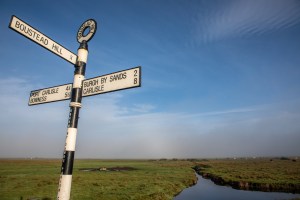
Most people come to Bowness on Solway to start the walk that follows the length of Hadrian’s Wall to Wallsend near Newcastle, but I went there because it’s unpopular. The Ordnance Survey map for the area – The Solway Firth – is number six in the least-best-selling of all the maps of England. It gets far fewer visitors than most other places and yet – and yet – it is absolutely lovely.
Setting out from Carlisle you reach Bowness by taking the long straight road that follows the line of Vallum, the huge ditch that follows the course of the wall. Running just below the high spring tide mark, it occasionally gets flooded. I loved this road. On one side was the ditch and embankment, on the other the saltmarsh and then the estuary. Beyond that, Scotland.
Beyond Bowness you head south along the coast through the Solway AONB and on towards Silloth another forgotten outpost. Across the water, as ever, Scotland lies, ready to pounce. It’s reassuring to see it there, solid and unbending and in total contrast to the mud flats and salt marshes of the south side.
Silloth feels like any quiet Victorian resort anywhere, except that it is out on a limb, in the middle of nowhere, at the edge of the coast, caught out by the disappearing railway – a victim of Beeching’s cuts – like a tourist stranded on a sand bank by the rising tide. The town retains its grandeur with Victorian brick-built terraces and cobbled streets. It’s genteel and yet it’s completely isolated. Fabulous.
PITCH UP AND CHILL AT
The Inn on the Bush at Kirkbride is a stopover for camper vans with an elsan point and water. innatthebush.co.uk/
DON’T MISS OUT ON
Heading further south on the B5300 to Maryport then the A596 to Workington and St Bees along the coast. It’s a great drive with wonderful views to the sea and, the further south you get, views to the peaks of the Western Lakes on the inland side. A great start to an adventure to Scafell or on the narrow gauge, steam-powered Ravenglass and Eskdale Railway up the glorious Eskdale.
8. ISLE OF ARRAN
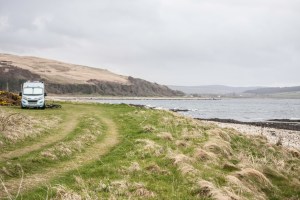
Arran is often described as Scotland in miniature because it has a little of everything Scotland has on the mainland. It has a peak, Goat Fell, that dominates at 874 metres, standing stones, caves (with a little bit of that magical Scottish lore), beaches, distilleries and castles. It’s also quite popular with campervans and campers so my advice would be to book your campsite (there are just a handful of them) before you book your ferry – Cal Mac (the ferry operator) may ask to see your booking.
You can easily tootle around Arran in a day if you wish but that’s not the point. Pitch up at the campsite at Lochranza and get on your bike, pull on your walking boots to sample a few of the whiskies at the Lochranza Distillery or visit the castle in its sublime setting at the head of the bay.
The west coast is more rugged and more sparsely populated than the south and east with wide views over to the Mull of Kintyre. This side is home to the King’s Cave, a favourite hangout of Robert the Bruce and his spider friend (allegedly), and the Machrie Moor standing Stones, a stunning set of stones in a wild setting. Further east is Lamlash Bay, site of the no take zone protected marine area, that’s unsurprisingly, well known for snorkelling. Pull on a wetsuit and dive in!
PITCH UP AND CHILL AT
Lochranza Caravan and Camping Site, a nice, open site that’s handy for the north, for walks to Fairy Dell and the distillery. arran-campsite.com
Bridgend Campsite and Cottage, a small, certificated site in the centre of Arran. Few pitches. Book ahead! bridgendholidaysshiskine.co.uk
Seal Shore Camping and Touring, an amazing site right on the shore. It’s small so book ahead to avoid disappointment. Snorkelling and fresh fish in season. Nice hotel bar next door. Book it! campingarran.com
DON’T MISS OUT ON
Visiting the King’s Cave, hidey hole in the cliffs near Blackwaterfoot where Robert the Bruce is said to have had his epiphany relating to spiders and never giving up the struggle. The stone circles at Machrie Moore are well worth the yomp over the moor. Boggy but brilliant. Take boots.
9. THE GALLOWAY COAST
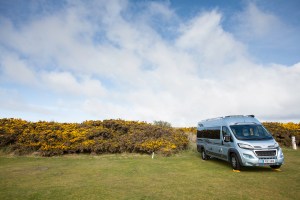
Bikes, books, dark skies, botanic gardens and great seaside driving…what more could you ask from a coastal campervan caper? The Galloway coast offers the lot.
Starting out from Dumfries, the A75 takes you west towards Wigtown, Scotland’s Book Capital and home of the Wigtown Book Festival, taking you through some interesting countryside before landing at the coast at Gatehouse of Fleet. Then it’s up the estuary to Newton Stewart, via Kirroughtree, a stop off that’s an absolute must for mountain bikers. It’s one of the 7stanes mountain bike centres and is fantastic, with hot showers, a jet wash and a slice of cake with a cup of tea in the cafe waiting for you afterwards. If you have a loo in your van you can pitch up overnight in the car park.
From Newton Stewart a short diversion will take you into the Galloway Dark Skies Park, perfect for star-gazing on clear nights. Then it’s down the coast to Garlieston and all around the bay on a road that stays near to the water almost all the way to Scotland’s most southerly village, Drummore. Along the way a stop at Logan Botanic Gardens will reveal huge tree ferns and plants not usually seen this far north. Fantastic!
PITCH UP AND CHILL AT
New England Bay Caravan Club Site, a site situated right on the water over looking Luce Bay and the Mull of Galloway, with excellent facilities, direct access to the beach and big, private pitches. tinyurl.com/57msde9s
Garlieston Caravan and Motorhome Club Site, a great site overlooking the bay in Garlieston. tinyurl.com/yjeeyfz3
DON’T MISS OUT ON
Visiting Logan Botanic Gardens, a garden that benefits from the Gulf Stream and is famed for its walled garden, fish pond and amazing collection of ferns.
10. THE COPPER COAST
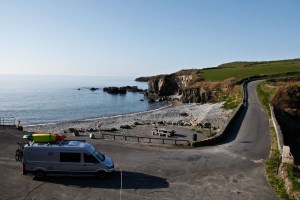
Most people who take vans to Ireland head straight for Cork and the Wild Atlantic Way. But not us. Our adventure in Ireland starts almost as soon as we get off the ferry at Rosslare. Head for Hook head Lighthouse, the oldest working lighthouse in the world. It’s well worth a stop.
From here head for Waterford but don’t go there – take the car ferry to Passage East and head for lovely Dunmore East. From Dunmore take the road to Tramore and then take the R675 out of town towards Dungarvan. This is the Copper Coast Road, a tourist route long before the Wild Atlantic Way was a thing. Today it’s a UNESCO Geopark with opportunities to explore its unique geology.
The route is fabulous for swimming, walking and chilling out at beaches like Stradbally and Annestown. The Guilamene Swimming Club, an open air sea pool of sorts just outside Tramore, is well worth a stop for a cool dip, while Bunmahon has been known to have surf.
When you reach Dungarvan it’s worth a stop at Clonea Strand for a walk and a dip. You can also pick up the Greenway to Waterford City here if you have the legs. It’s a fantastic cycle even if you only do a few miles. The views as you approach Dungarvan are wonderful.
PITCH UP AND CHILL AT
Roches Campervan and Motorhome Stop is a good stop when you get off the ferry. Handy. tinyurl.com/ak94bzjd
Quanns, Dungarvan is a council-run motorhome stopover in Dungarvan. Handy for town, where there are some great restaurants. tinyurl.com/muvp5rre
DON’T MISS OUT ON
Ditching the van and cycling the Greenway to Waterford to explore the Viking Quarter, a recent development to celebrate Waterford’s Viking past. Lots of museums and attractions there to keep you amused. When you get back, Dungarvan has a thriving restaurant and bar scene and a huge central square plus attractive waterfront.
11. CAUSEWAY COAST, NORTHERN IRELAND
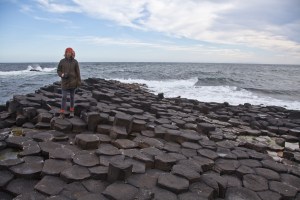
There is little doubt that the Causeway Coast is one of the world’s finest coastal drives. From Belfast to Derry, it pootles through 200 miles of gorgeous coastal scenery, at times just a few metres above the sea, throbbing in perpetual motion between the waves and the mountains.
These days people come here for more than just the castles, caves and beaches. Since Game of Thrones was shot here a few of the film locations have become more famous than the simple tourist attractions they once were. The Glens of Antrim, Dunluce Castle, Cushendun Caves, Murlough Bay, Ballintoy Harbour and The Dark Hedges are places well known by fans, even if they were well known to tourists before GoT.
As with all these places, getting there early is par for the course on busy summer days, especially if you want to get to the Dark Hedges or The Giant’s Causeway before the influencers and ’grammers are pouting about. That said, even with a storm of digital nomads crashing every frame, these places are still magnificent, beautiful, magical, transcending mere celluloid with one waft of the breeze. Just go.
PITCH UP AND CHILL AT
Jordanstown Loughshore Park, a fantastic facility on the shores of Belfast Lough that’s council-run. Great showers, online booking, grey and black water and great views. Also there’s a cafe on site. Security is excellent. tinyurl.com/39uypvea
Glenariff Forest Park Touring Site is a motorhome only site that’s protected by a barrier. It has full facilities and hardstanding for all pitches. You can book online (recommended) or pay at the park. tinyurl.com/2y5s7ekt
DON’T MISS OUT ON
The Gobbins Cliff Path, an Edwardian attraction that takes walkers on a sea level tour of the cliffs and caves of this part of the coast. It’s been modernised in recent years with new walkways and a visitor centre. Glenariff Forest Park also offers a similar kind of walk but through a gorge with stunning waterfalls. Amazing scenery and walking trails.
12. WILD ATLANTIC WAY, CLIFDEN, COUNTY GALWAY
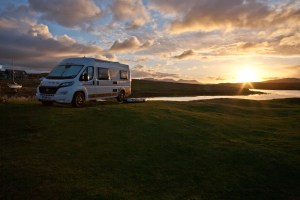
You can take the N59 between Galway and Clifden and it would be lovely, but that’s not the point. I want you to taste the salt air and feel the undulating bog roads beneath your wheels as you twist and turn on this lovely section of the 3,000-mile long Wild Atlantic Way. No point in rushing it and missing out on the best stuff – it isn’t something to be ticked off a list.
There are good reasons for focussing on this section. It isn’t one of the big hitters like the Ring of Kerry or Achill but it has its own joys, and plenty of them. When you cruise out of Galway through Salthill and take to the Sky Road above Clifden – spotting dolphins between the islands below you – you will thank me.
Galway’s fractal coastline means there are beaches, bays and inlets to explore. Try Coral beach for silver sands and a turquoise sea. For those in search of their Celtic roots it doesn’t get much better than Galway for Irish culture, music and food. Clifden, at the other end of the journey, is something else: a gem of a place with a big heart at the edge of the world. As the Irish say, “May the road rise to meet you and the wind be always at your back.”
PITCH UP AND CHILL AT
Salthill Caravan Park, is at the western end of Salthil’’s seafront. Well placed for a sea swim at Salthill’s swimming beach. salthillcaravanpark.com
Clifden Eco Beach Camping, is a basic but wonderful, multi-award-winning eco campsite with its own beach and an enimatic owner. Go, stay, take a fishing rod, say I told you. You will love it. clifdenecocamping.ie
DON’T MISS OUT ON
Pearse’s Cottage, especially if you are chasing your Irish roots. Pádraig Pearse was an Irish nationalist and patriot and leader of the 1916 Easter Rising. There is a visitor centre here, adjacent to the cottage, which is now a national monument.
The Sky Road is one of the best sections of the Wild Atlantic Way, as the name would suggest. Fantastic for views of the islands and bays and a real treat to be driven slowly.
Martin’s books, including Off the Beaten Track: England and Wales, and his Take the Slow Road series are available at all good bookshops and from online retailers. Buy signed copies from martindorey.com.
Read Martin Dorey’s recent column for Coast on the effect of disposable BBQs on the beach.

